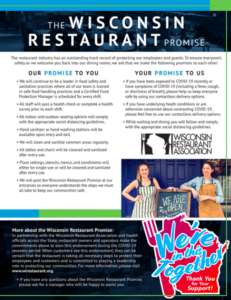
Everything COVID-19 seems to be moving at light speed these days. Well, everything except for the reopening of Wisconsin’s economy.
So, your friendly neighborhood MacIver staff decided to bring together in one place the recent information and data you need to know about COVID-19. Hopefully, this will be a place you can navigate to on a regular basis to catch up on the underreported stories, analysis and research that can get lost in the hustle and bustle of life, even in a pandemic lockdown.
If you have come across an article or a piece of research you think your friends and neighbors would find interesting, send us your suggestion at info@maciverinstitute.com and we will add it to the pile. Thanks.
Wisconsin’s Guides to “Safe at Work”
By Rebecca Kleefisch
ABC of Wisconsin Jobs Ambassador
Wisconsin has fresh hope for an eventual “return to normal” with the most-recently issued emergency order to combat the coronavirus pandemic, but the “new normal” may temporarily look a little different.
The construction industry knows what that’s like. After the coronavirus swept the country, construction workers – like delivery people, truckers, grocers and others – kept working, albeit with even more stringent safety standards. That’s why Associated Builders and Contractors of Wisconsin and its members stand ready to help our neighbors and friends in the economy navigate how to re-enter this state of “semi-normal” … safely. We have done it, and we want to share how.
Construction can’t really press “pause” indefinitely. Hospitals need improved infrastructure to get people well in better ways. Families need infrastructure maintained to protect drinking water, ensure electricity and keep communication open. Businesses, schools, governments and households need infrastructure built for evolving expectations and growing needs.
So, when COVID-19 started ripping through our nation, the construction industry had to act fast to figure out how to achieve both safety and continued results. Turns out they were good at solving that puzzle, because building safely is what they do every day.
On construction sites across Wisconsin today, there are new safety procedures geared toward keeping workers healthy. There are more hand-washing stations and tool sanitation. Portable restrooms are changed more frequently, the hand sanitizer level is checked more frequently, and jobsite door handles are disinfected more frequently. Some companies have chosen to tent entry points and take workers’ temperatures at a distance to make sure they don’t come to the job with a fever. Other contractors have workers record their own temperatures and answer a series of health questions before they come on-site. There are social distancing rules that trigger ingenuity: workers are performing tasks on a lift one at a time, using masks regularly, and taking breaks in their vehicles instead as a group in trailers.
To read the entire column, click here.
Everyone knows that one of the industries hit the hardest by COVID-19 has been the restaurant industry. Many of our favorite places to eat are struggling to keep the doors open during this lockdown. If something doesn’t change soon, it will be too late for thousands of restaurants who will be closed forever. Did you know that the Wisconsin Restaurant Association has a plan, the Wisconsin Restaurant Promise, for restaurants to reopen safely following new procedures and guidelines?
Read about the plan here.
Use Pearl Harbor as model for coronavirus response
When Japan bombed Pearl Harbor in 1941, the United States was shocked and stunned. Caught on the backfoot, we were practically stupefied by the surprise attack, but that didn’t last long.
By 1945, America had more than quintupled the size of its armed forces, tripled the size of its navy escort fleet, and grown into an industrial power absolutely unrivaled across the world. To this day, that wartime mobilization is the greatest testament to this country’s ingenuity and willpower and the most shining victory in the history of American ideals. In his diary, a Japanese admiral said that Japan had awoken the U.S., “a sleeping giant, and filled it with resolve.” The world would never be the same.
Fast-forward to 2020, and our country has been caught by surprise once more. “This is our Pearl Harbor moment,” the surgeon general warned. Only this time, our enemy is a virus, our battlefields are our bodies, and the war we’re fighting takes place at home.
If the U.S. is to win this war against the coronavirus, we need to fashion a response to rival our triumph after the original Pearl Harbor. We need bold plans and innovative new ways to counter this threat, take up the offensive, and mobilize American greatness.
The key, then as now, is the economy. We need new strategies to liberate our economy from the crippling effects of the coronavirus and unleash the power and potential both of enterprise and each worker’s fighting spirit.
Time isn’t on our side, and, right now, we’re wasting it. The shutdowns implemented across the country were always nothing more than a temporary measure, a momentary retreat to buy us some time and recollect our forces. A shutdown is not a long-term solution. We cannot win this war by cowering indoors until the virus goes away.
To Read Bob’s entire column, please click here.
